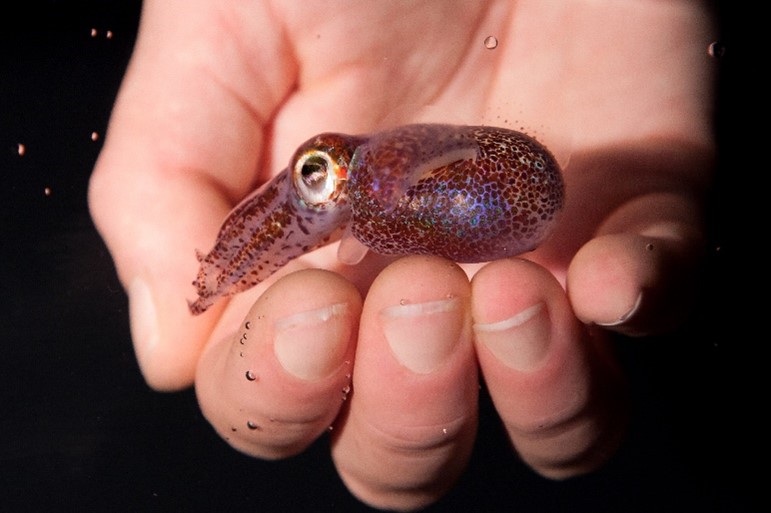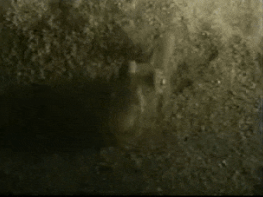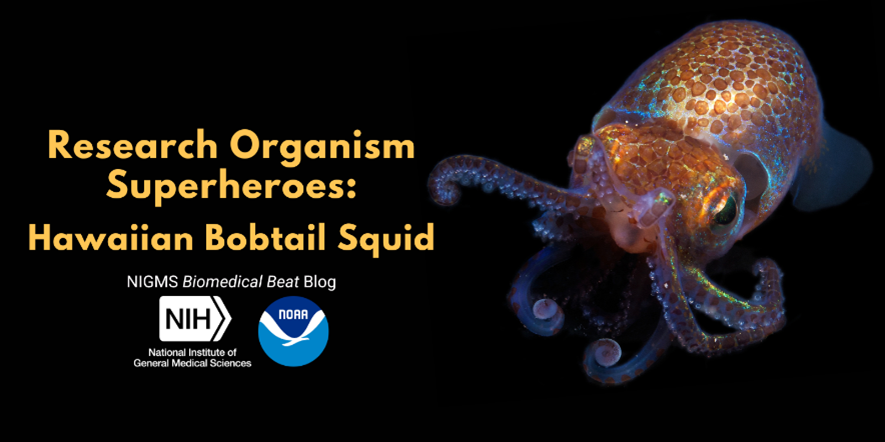
The Hawaiian bobtail squid (Euprymna scolopes) is only about as big as a golf ball, but what it lacks in size, it makes up for in its superpower—an invisibility cloak to be exact. Thanks to its symbiotic relationship with the bioluminescent bacteria Vibrio fischeri, it’s able to seemingly disappear from its predators when swimming at night.
These super-squid live in the shallow coastal waters in the Pacific, like those around the Hawaiian Islands. They’re nocturnal, so they hunt their prey—small shrimp and other crustaceans—at night and hide, often by burying themselves in the sand, during the day while they rest. Although Hawaiian bobtail squid live their short 3-10 month lives around one another, they generally only interact for breeding, and even then, they only reproduce once in their lifetimes and die soon after reproduction.

Almost immediately after hatching from their eggs, the baby squid begin secreting a special mucus that attracts Vibrio fischeri bacteria to their light organ—a part of the squid with cavities for the bacteria to colonize that has some similar features to, but also distinct differences from, an eye. The bacteria enter the light organ, quickly multiply to form a biofilm, and begin producing light. The light organ, in combination with the squid’s ink sac, controls the level of bioluminescence the squid emits. This dimmer switch allows the squid to mimic the brightness of moonlight that shines through the shallow waters to eliminate its shadow—and create its invisibility cloak. The light emission is cyclical, with a complex circadian rhythm of being brighter at night and dimmer during the day.
Bioluminescence is visible light that a living organism produces through a chemical reaction. The light is often blue or blue-green but can also be bright purple, green-yellow, and red! Bioluminescence is uncommon on land (although you’ve probably seen it occur in fireflies), but it is common in marine life, from bacteria to squid and fish. It can help organisms locate food, defend against or hide from predators, attract prey or mates, and communicate. Find out more in the fact sheet from the National Oceanic and Atmospheric Administration (NOAA).
Both the squid and the bacteria make great research organisms, but scientists are especially interested in their symbiotic relationship. Because the squid parents don’t raise their young in the wild, the hatchlings are also self-sufficient in the lab and have enough nutrients from their yolk sacs to survive without food until they establish a bacterial partnership. And, due to their small size, researchers can view hatchlings’ entire bodies using confocal microscopy. Researchers can readily grow the bacteria in the lab and even change their genetic composition for experimentation. Together, researchers can study the symbiotic pair from the relationship’s formation through maturity in a short time frame, thanks to the squid’s short lifespan, as well as track the partnership levels noninvasively through light output.

NIGMS funds researchers who investigate the Hawaiian bobtail squid and its relationship with the bioluminescent bacteria. Some explore the symbiotic nature of their partnership in an effort to better understand how we partner with microbes in our microbiomes or how the bacteria communicate during this partnership. Because the Vibrio fischeri bacteria are related to bacterial species that infect humans, other researchers investigate thebiofilms they form with the aim of increasing our ability to treat the infectious biofilms that cause disease in humans.
You can also tell us your favorite research organism, and we might feature it in a future post!

This post is a great supplement to our bobtail squid coloring page. Learn more in our Educator’s Corner.






